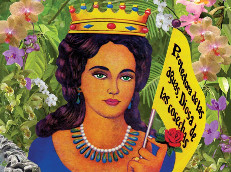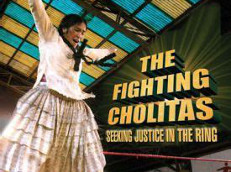This of this weeks reading by Roger Canals titled “The mirror effect: seeing and being seen in the cult of Marıa Lionza” was of particular interest to me because I seemed to keep drawing parallels between certain aspects of their practices and the religion that I grew up in. BIG disclaimer I was baptized and […]
Posted in Blogs, Religion | Tagged with
This of this weeks reading by Roger Canals titled “The mirror effect: seeing and being seen in the cult of Marıa Lionza” was of particular interest to me because I seemed to keep drawing parallels between certain aspects of their practices and the religion that I grew up in. BIG disclaimer I was baptized and […]
Posted in Blogs, Religion | Tagged with Marıa Lionza
I found this week’s reading and videos especially interesting. Growing up I never understood the religious rules and practices used by my Colombian family. For example, baby cousins wear a bracelet to protect them from “Mal de ojo” (evil eye). Even after childhood, we are warned to protect ourselves from it. Or the use ofContinue reading “Week 8: Religion LAST 201”
Posted in Blogs, Religion | Tagged with
Edit: Totally forgot we were supposed to write something in preparation for the final project, ha… Roger Canals’s essay, “The mirror effect: seeing and being seen in the cult of María Lionza (Venezuela)”, reminded me of several critical theorists, including Susan Sontag. Through essays and, later, her book On Photography, Susan Sontag explores the materialContinue reading “The Camera as a Mediator of Imagination and Popular Culture”
Posted in Blogs, Film, Photography, Religion | Tagged with
Feeling Collective: The Queer Politics of Affect in the Riot Grrrl Movement, Kate Siegfried In the article “Feeling Collective: The Queer Politics of Affect in the Riot Grrrl Movement”, Kate Siegfried coherently outlines the Riot Grrrl movement by showcasing its history and its effect on popular culture. She begins by highlighting what this underground movementContinue reading “Somos Mulheres Não Utensílios: Riot Grrrl in Brazil”
Posted in Blogs, Music | Tagged with
The readings this week were closely related and vastly interesting pieces of information that I had not been exposed to before this week, much like Shaylih Muehlmann’s experience in “A Narco without a Corrido Doesn’t Exist”. Although I spent most of my life in Houston,Texas where cultures often mingle and are admired by a very diverse population, I wondered why I had never been taught this subculture in class. My knowledge gained of narco-corridos felt akin to looking at an optical illusion image of an old woman and a young woman at the same time (you may be more familiar with the one that shows black and white vases). It was often more difficult for me to find the second image in the optical illusion until someone pointed it out to me. Sometimes by seeing the negative of an image, or what is left in the abstract space of it, we can learn more about the whole image itself. So now that I see what the United States has taught me about narco culture (or therefor lack of) I can understand why it is not included in mainstream education: mainly that the United States is begrudgingly dependent upon the drugs supplied by Mexico. To engrain narco culture in US pop culture would be giving attention to a phenomenon that has not problem finding the limelight. In the interview between Jon and Shaylih, she mentioned that narco culture was closely intertwined with fashion elements of ranchero culture and religious symbolism that describes the amorphous set of practices associated with this counter-culture. I would classify narco-corrido genre as counter-culture because it opposes social norms. On the boarder, low income residents are often made to feel at fault for the trafficking taking place. Because music permeates culture in a way where even if you cannot understand the lyrics or even do not speak the language you can feel the emotions behind it, narco-corridos are enjoyed by a wide demographic of people who have become unintentionally entangled in conflict between narcos and federales. Instead of villainizing the narcos, the corridos immortalize narcotraficantes with feelings of power, pride, defiance, and hope. Just as in the idealization of hippie counter-culture, these songs forget to include consequences of drug addiction such as spending swaths of time in prison and the trauma that accompanies extreme violence. The other readings, “The Cultural Life of Coco” by Alison Spedding and “The Coca War: Testimony of Chapare Peasants” provide supplemental information about the cultural significance of coca, which is used regionally by indigenous civilians for livelihood and celebrations of life, death, and birth. Narco-corridos are not solely songs about the corruption of drug trafficking all over Latin America, it seems to report specifically on the blazing guns and revving engines that ignite across the US – Mexico boarder. These songs do not spare a verse to the coca farmers who have their crops excavated by army droves. When seeing these two pieces of the picture, one brightly announced to your ears and flashily glorified in song while the other lurks in the background, taking advantage of those less likely to fight back. The shadow of narco-corrido culture’s flashy lights can be seen as plainly as catchy songs are heard on the radio. One is responsible for uprooting folk culture and the other grows fueled by the neoliberal fantasy of quick accumulation.
Posted in Blogs, Drugs | Tagged with


